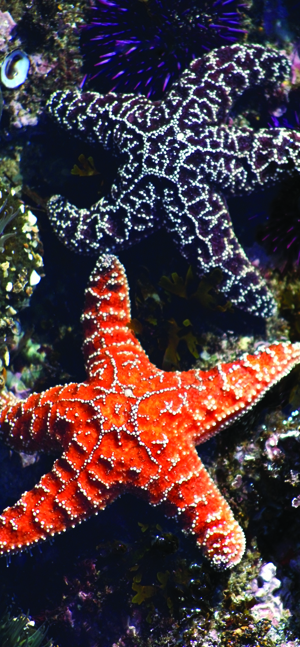 West Coast starfish have been holding on for dear life since 2013, fighting to survive a mysterious disease that first appeared off the Olympic Peninsula and resulted in the loss of millions of bright-colored stars that light up the dark waters of the Pacific. The disease, now identified as the sea star wasting syndrome, first affected ochre sea stars (the most common species), mottled sea stars, leather stars, and six-armed stars before dramatically spreading to additional species from Alaska to Mexico.
West Coast starfish have been holding on for dear life since 2013, fighting to survive a mysterious disease that first appeared off the Olympic Peninsula and resulted in the loss of millions of bright-colored stars that light up the dark waters of the Pacific. The disease, now identified as the sea star wasting syndrome, first affected ochre sea stars (the most common species), mottled sea stars, leather stars, and six-armed stars before dramatically spreading to additional species from Alaska to Mexico.
Affected sea stars now include the sunflower star, rainbow star, giant pink star, giant star, vermilion star, and bat star, with the sunflower and ochre stars experiencing the most geographically expansive and well-documented declines. Though reports have shown signs of recovery in small areas of southern California, there is no evidence of a wide-scale recovery, and the disease is still affecting a substantial amount of starfish along North America’s Pacific Coast.
The disease is gruesome, with the initial symptom of decaying lesions. The sea stars’ arms then begin crawling away from its body during the fragmentation stage. Lucky enough for sea stars, regeneration is in their genes. However, if the sores open, internal organs are likely to extrude from the deflated starfish and most stars can’t survive. Sometimes the disease runs its course within just a few days. Similar disease-related sea star events have happened before, but not quite to this extent. It’s hypothesized that environmental conditions may have contributed to the outbreak, but the cause of the wide-spread disease remains unknown.
Even with this devastation, one thing’s evident — our sea stars are incredibly resilient. Even with no signs of full recovery on the horizon, these robust echinoderms are far from extinct. Their ability to produce thousands of offspring, with an average lifespan of 30 years, helps in their fight for survival. Last year’s babies are now under the scope of observation and are continuing to grow and mature with only a small number affected by the disease.
However, the slow loss of a vital species doesn’t go without some sort of ecological shift. Urchins are on the rise without their sunflower star predators, causing more algae-dominated communities and large areas of bare rock and crustose algae called “urchin barrens.” It’s an ongoing issue in our Pacific waters, one that scientists aren’t taking lightly.